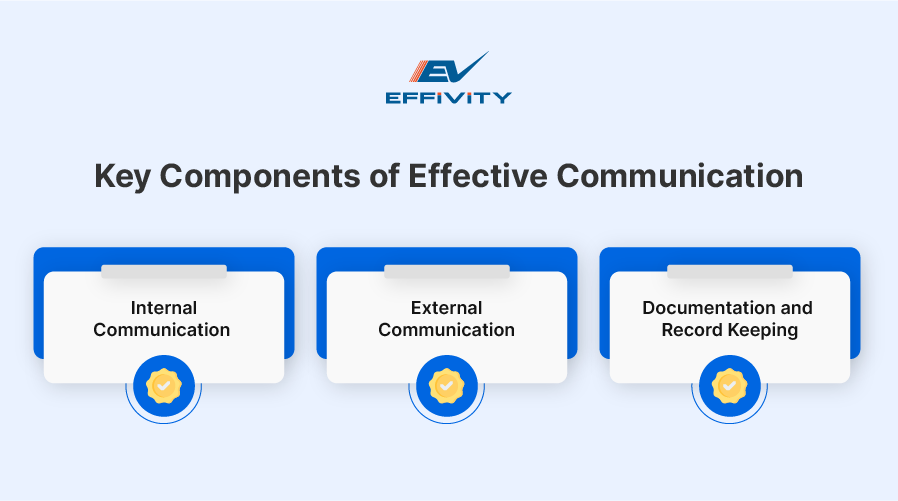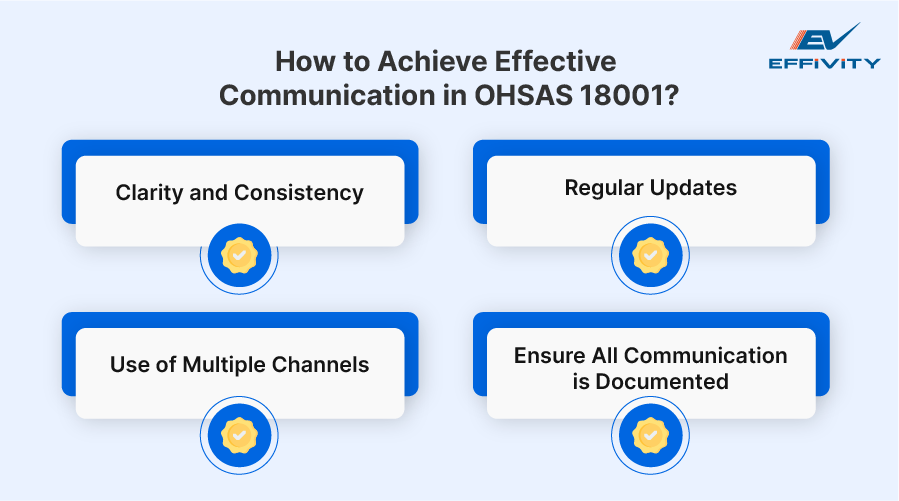A well-defined and managed OHSAS 18001 system benefits the organization by demonstrating its commitment to employee health and safety, thereby improving the performance, reputation, and overall efficiency of the company.
While you have a strong occupational, health, and safety management system with the right inputs, processes, and procedures to achieve OHSAS 18001 certification, all your efforts can be in vain if this system is not supported by even stronger communication.
This is probably why communication is one of the important requirements laid out within the OHSAS 18001 standard to enhance its performance. In this article, we’ll understand what communication in the occupational health is and safety management system and how to achieve effective communication in OHSAS 18001.
What Does OHSAS 18001 Standard Specify?
OHSAS 18001 communication requirements are dealt with in clause 4.3.3 of the standard. The standard requires that any organization design procedures for effective internal and external communication and ensure that documents from stakeholders are processed correctly.
Within the sub-clause for Communication, Participation, and Consultation, organizations need to define processes regarding-
-
Internal communication
procedures need to define how effective communication among the levels of the company is achieved. -
External communication
procedures must describe how the external communication is received, documented, and responded to.
The standard advocates that top management should be responsible for ensuring that the Health & Safety system performs as expected, which requires them to implement clear and strong communication processes.
As a result, it also makes sense that one person is responsible for communication to avoid miscommunication among stakeholders, though with assistance from Health and Safety team members.
Key Components of Effective Communication

Internal Communication
Internal communication is the backbone of an effective OHSMS. OHSAS 18001 mandates that organizations establish, implement, and maintain procedures for internal communication among various levels and functions. This can include:
1. Communicating Safety Policies and Objectives
The safety policy and objectives must be communicated to all employees. Everyone in the organization should understand the safety procedures and how they contribute to achieving the objectives.
2. Conducting Employee Awareness and Training Programs
Employees must be aware of the health and safety policies, procedures, and their responsibilities. Regular training sessions, workshops, and safety meetings can be conducted to keep the staff informed and updated.
3. Developing Feedback Mechanisms
Establishing channels for employees to provide feedback on health and safety issues is crucial. This can be done through suggestion boxes, health and safety committees, or regular meetings where employees can voice their concerns and suggestions.
External Communication
External communication involves procedures for receiving and managing communication from stakeholders outside the organization, such as contractors, suppliers, regulatory bodies, and the community.
Additionally, organizations must communicate their health and safety policies and performance to external stakeholders, including regulatory bodies, clients, and suppliers. This ensures transparency and builds trust with all parties involved.
Moreover, in the event of an incident, organizations must also have clear procedures for reporting to regulatory bodies and other stakeholders. Preparing detailed documentation and timely communication is critical to prevent recurrence and ensure compliance with legal requirements.
Documentation and Record Keeping
Efficient documentation and record-keeping can help support the OHSAS performance by ensuring access to the right information at all times. Thus, it also becomes a critical aspect of communication within OHSAS 18001.
Maintaining accurate and up-to-date records of health and safety policies and procedures, along with internal and external communications, is essential to maintain transparency and accountability. This not only ensures compliance but also provides a basis for continuous improvement.
Further, documents should be easily accessible to all employees. It can be achieved through automated OHSMS software solutions or physical copies available at strategic locations within the workplace.
How to Achieve Effective Communication in OHSAS 18001?
There are various ways to achieve effective communication in occupational health and safety systems to ensure it reaches the intended stakeholders-

1. Clarity and Consistency
All communication should be clear, concise, and consistent across all levels of the organization. To ensure understanding, avoid jargon and ensure that the information is seamlessly shared with all employees.
2. Regular Updates
It is important to share regular updates on safety performance, incidents, and procedure changes to keep employees informed and engaged.
3. Use of Multiple Channels
Consider establishing various communication channels to ensure the information reaches all the relevant stakeholders promptly. These include-
A. Email communication:
Email is an effective channel for sharing important information with both internal and external stakeholders. Building an email list of all internal and external parties can help ensure they receive updates regularly.
B. Notice boards:
Any news or changes within the organization or important legislative documents can be displayed on a notice board, whether physical or electronic, for effective internal communication. Notice boards can also be used to display important performance or OHSAS metrics.
C. On-site sessions and meetings:
Holding weekly or monthly update meetings can allow you to share any new OHSAS processes, changes in legislation, or other developments with the team.
D. Employee forums:
An employee forum can be a reliable tool to encourage employees to exchange ideas, receive information, or share feedback to improve OHSAS performance.
4. Ensure All Communication is Documented
Since proving effective communication is a requirement of the OHSAS 18001 standard, you must ensure that all communication is documented and recorded accurately.
For this, you must establish a process for receiving, storing, and versioning external documentation required for your OHSAS system. Communication is important, but you must ensure you communicate the correct information and version.
Further, signing documents and changes in legislation electronically can help make sure that staff has received confirmation of changes, and you can update the relevant records for reference.
The Downside of Poor Communication
Lack of knowledge resulting from ineffective communication is often the root cause of many accidents in the workplace. Ineffective communication can have serious implications on the overall safety of your employees. If employees and contractors don’t fully understand internal processes, first aid kit locations, fire muster points, or any legislation changes, it might lead to ineffective safety management and increased risk.
Poor communication can also affect internal audits and risk assessment as the results might not promptly be communicated to the organization. Irrespective of how good your processes are, they will not work effectively if not communicated properly to stakeholders.
As a result, strong communication among stakeholders within and outside the organization is important for reaching your Health and Safety objectives. Overcoming communication challenges through innovative solutions such as OHSMS software further strengthens the systems, ensuring the safety and well-being of all stakeholders.






























